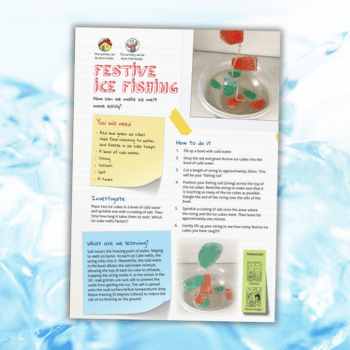How can we make ice melt more easily? Find out with this festive melting ice experiment from the 15-Minute STEM series by Emily Hunt…
Resources
- Red and green ice cubes (add food colouring to water and freeze in ice cube trays)
- Bowl of cold water
- String
- Scissors
- Salt
- Timer
Melting ice experiment learning objective
Salt lowers the freezing point of water, helping to melt ice faster. In this melting ice experiment, as each ice cube melts the string sinks into it. Meanwhile the cold water in the bowl dilutes the salt/water mixture, allowing the top of each ice cube to refreeze, trapping the string inside it.
In the winter in the UK, road gritters use rock salt to prevent the roads from getting too icy. The salt is spread onto the road surface before temperatures drop below freezing (0 degrees Celsius) to reduce the risk of ice forming on the ground.
Curriculum links
- Year 4 (States of Matter)
- Year 5 (Properties and Changes of Materials)
Emily Hunt is an experienced primary school teacher with a passion for promoting STEM education. She regularly writes articles and speaks about STEM, and shares activities and blogs on her website. Emily holds a Masters of Education from the University of Cambridge and has also worked within the US education system to deliver science outreach.
Download another ice-themed lesson plan or a KS2 states of matter medium-term plan.














